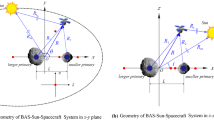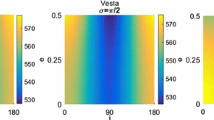Abstract
Different types of orbits in the vicinity of a binary asteroid system have been studied extensively, motivated by the challenging dynamical environment and ongoing space missions. This work addresses a new type of orbit that may have potential application in missions around the BAS—the forced hovering orbit (FHO) above the primary. The dynamics model of the FHO considers two major perturbations, from the secondary’s gravity and from the solar radiation pressure. The primary is modelled as a tri-axial ellipsoid, and its second degree and order-gravity field is adopted. The secondary is taken as a sphere. In the body-fixed frame of the primary, we firstly construct high-order analytical solutions of the FHO around the ‘equilibrium’ point. Then, depending on the relative strength of the SRP and the secondary’s gravity perturbation, the analysis is further carried out in three cases: the SRP-dominating case, the secondary-dominating case, and the competitive case in which the strength of the SRP and the secondary’s gravity perturbation is comparable with each other. Analysing the discovered BAS in the solar system, we find that all three cases exist, with the competitive case the most common. In the secondary-dominating case, a resonance may arise between the secondary’s orbital frequency in the primary’s body-fixed frame and one intrinsic frequency around the ‘equilibrium’ point. In the competitive case, we use the fast Lyapunov indicator (FLI) to characterize the stability of the FHO. Finally, using the analytical solution as an initial seed, we employ the multiple shooting method to design quasi-periodic FHO in (66391) Moshup and Squannit. These orbits may have potential applications in exploiting the BAS.











Similar content being viewed by others
Data availability
The datasets generated during and/or analysed during the current study are available in the ‘Asteroids with Satellites’ website, http://www.johnstonsarchive.net/astro/asteroidmoons.html. Other datasets in this work are available from the corresponding author on reasonable request.
References
Bellerose, J., Scheeres, D.J.: Stability of equilibrium points in the restricted full three-body problem. Acta Astronaut. 60(3), 141–152 (2007). https://doi.org/10.1016/j.actaastro.2006.07.009
Bellerose, J., Scheeres, D.J.: General dynamics in the restricted full three body problem. Acta Astronaut. 62(10), 563–576 (2008). https://doi.org/10.1016/j.actaastro.2008.01.018
Bellerose, J., Scheeres, D.J.: Restricted full three-body problem: application to binary system 1999 kw4. J. Guid. Control Dyn. 31(1), 162–171 (2008). https://doi.org/10.2514/1.30937
Broschart, S.B., Lantoine, G., Grebow, D.J.: Quasi-terminator orbits near primitive bodies. Celest. Mech. Dyn. Astron. 120(2), 195–215 (2014)
Chappaz, L., Howell, K.C.: Exploration of bounded motion near binary systems comprised of small irregular bodies. Celest. Mech. Dyn. Astron. 123(2), 123–149 (2015)
Damme, F., Hussmann, H., Wickhusen, K., et al.: Stable orbits in the didymos binary asteroid system - useful platforms for exploration. In: EGU General Assembly 2016 (2016)
Dell’Elce, L., Baresi, N., Naidu, S., et al.: Numerical investigation of the dynamical environment of 65803 didymos. Adv. Space Res. 59(5), 1304–1320 (2017). https://doi.org/10.1016/j.asr.2016.12.018
Feng, J., Hou, X.: Dynamics of equilibrium points in a uniformly rotating second-order and degree gravitational field. Astron. J. 154(1), 21 (2017)
Feng, J., Hou, X.Y.: Secular dynamics around small bodies with solar radiation pressure. Commun. Nonlinear Sci. Numer. Simul. 76, 71–91 (2019)
Ferrari, F., Lavagna, M., Howell, K.C.: Dynamical model of binary asteroid systems through patched three-body problems. Celest. Mech. Dyn. Astron. 125(4), 413–433 (2016)
Froeschle, C., Guzzo, M., Lega, E.: Graphical evolution of the arnold web: from order to chaos. Science 289(5487), 2108–2110 (2000)
Froeschlé, C., Lega, E., Gonczi, R.: Fast lyapunov indicators. Application to asteroidal motion. Celest. Mech. Dyn. Astron. 67(1), 41–62 (1997)
Gabern, F., Koon, W.S., Marsden, J.E.: Spacecraft dynamics near a binary asteroid. In: Conference Publications, American Institute of Mathematical Sciences, p. 297 (2005)
Gomez, G.G., Masdemont, J., Sim, C.: Quasihalo orbits associated with libration points. J. Astron. Sci. 46(2), 135–176 (1998)
Hou, X., Xin, X.: a note on the full two-body problem and related restricted full three- body problem. Astrodynamics 2(1), 39–52 (2018)
Hou, X., Scheeres, D.J., Xin, X.: Mutual potential between two rigid bodies with arbitrary shapes and mass distributions. Celest. Mech. Dyn. Astron. 127(3), 369–395 (2017)
Hou, X., Xin, X., Feng, J.: Genealogy and stability of periodic orbit families around uniformly rotating asteroids. Commun. Nonlinear Sci. Numer. Simul. 56, 93–114 (2018)
Hou, X.Y., Xin, X.S., Feng, J.L.: Forced motions around triangular libration points by solar radiation pressure in a binary asteroid system. Commun. Nonlinear Sci. Numer. Simul. 4(1), 17–30 (2020)
Howell, K.C., Pernicka, H.J.: Numerical determination of lissajous trajectories in the restricted three-body problem. Celest. Mech. 41(1), 107–124 (1987)
Jean, I., Misra, A.K., Ng, A.: Solar radiation pressure-compatible trajectories in the vicinity of a binary asteroid. J. Guid. Control Dyn. 42(6), 1319–1329 (2019)
Jorba, A.: A methodology for the numerical computation of normal forms, centre manifolds and first integrals of hamiltonian systems. Exp. Math. 8(2), 155–195 (1999)
Kaula, W.M., Street, R.E.: Theory of Satellite Geodesy: Applications of Satellites to Geodesy. Blaisdell Pub Co, Waltham (1966)
Lantukh, D., Russell, R.P., Broschart, S.: Heliotropic orbits at oblate asteroids: balancing solar radiation pressure and J2 perturbations. Celest. Mech. Dyn. Astron. 121(2), 171–190 (2015)
Lukjanov, L.G.: A study of asymptotic solutions in the vicinity of the collinear libration points of the restricted three-body problem. Celest. Mech. 15(4), 489–500 (1977)
Margot, J.L., Nolan, M., Benner, L., et al.: Binary asteroids in the near-earth object population. Science 296(5572), 1445–1448 (2002)
Michel, P., Cheng, A., Kuppers, M., et al.: Science case for the asteroid impact mission (aim): a component of the asteroid impact and deflection assessment (aida) mission. Adv. Space Res. 57(12), 2529–2547 (2016). https://doi.org/10.1016/j.asr.2016.03.031
Morrison, D.D., Riley, J.D., Zancanaro, J.F.: Multiple shooting method for two-point boundary value problems. Eng. Comput. 20(1), 31–37 (1962)
Morrow, E., Scheeres, D.J., Dan, L.: Solar sail orbit operations at asteroids. J. Spacecr. Rockets (2001)
Near, L., Villac, B.F., Scheeres, D.J.: A simple algorithm to compute hyperbolic invariant manifolds near l1 and l2. Aas/aiaa Spaceflight Mechanics Meeting (2004)
Ogawa, N., Terui, F., Mimasu, Y., et al.: Image-based autonomous navigation of hayabusa2 using artificial landmarks: the design and brief in-flight results of the first landing on asteroid ryugu. Astrodynamics 4(2), 89–103 (2020)
Pravec, P., Scheirich, P., Kušnirák, P., et al.: Photometric survey of binary near-earth asteroids. Icarus (2006)
Pravec, P., Scheirich, P., Vokrouhlickỳ, D., et al.: Binary asteroid population. 2. Anisotropic distribution of orbit poles of small, inner main-belt binaries. Icarus 218(1), 125–143 (2012)
Pravec, P., Scheirich, P., Kušnirák, P., et al.: Binary asteroid population. 3. Secondary rotations and elongations. Icarus 267, 267–295 (2016)
Qian, Y.J., Zong, K., Yang, X.D., et al.: Forced resonance orbit analysis of binary asteroid system with consideration of solar radiation pressure. Nonlinear Dyn. 1–24 (2022)
Sawai, S., Scheeres, D.J., Broschart, S.: Control of hovering spacecraft using altimetry. J. Guid. Control Dyn. 25(4), 786–795 (2002)
Scheeres, D.J.: Dynamics about uniformly rotating triaxial ellipsoids: applications to asteroids. Icarus 110(2), 225–238 (1994)
Scheeres, D.J.: Satellite dynamics about small bodies: averaged solar radiation pressure effects1. J. Astron. Sci. 47(1), 25–46 (1999)
Scheeres, D.J.: Orbital Motion in Strongly Perturbed Environments: Applications to Asteroid, Comet and Planetary Satellite Orbiters. Springer Praxis Books, Cham (2012)
Scheeres, D.J., Bellerose, J.: The restricted hill full 4-body problem: application to spacecraft motion about binary asteroids. Dyn. Syst. 20(1), 23–44 (2005). https://doi.org/10.1080/1468936042000281321
Scheeres, D.J., Sutter, B., Rosengren, A.: Design, dynamics and stability of the osiris-rex sun-terminator orbits. Adv. Astron. Sci. 148, 3263–3282 (2013)
Scheeres, D.J., McMahon, J., Bierhaus, E., et al.: Janus: a nasa simplex mission to explore two neo binary asteroids. Bull. AAS https://baas.aas.org/pub/2020n4i401p04, https://baas.aas.org/pub/2020n4i401p04 (2020)
Shi Yu, W., et al.: Equilibrium points and associated periodic orbits in the gravity of binary asteroid systems: (66391) 1999 kw4 as an example. Celest. Mech. Dyn. Astron. Int. J. Space Dyn. 130(4) (2018)
Shi, Y., Wang, Y., Xu, S.: Global search for periodic orbits in the irregular gravity field of a binary asteroid system. Acta Astronaut. 163, 11–23 (2019). https://doi.org/10.1016/j.actaastro.2018.10.014
Tsiganis, K., Kueppers, M., Michel, P., et al.: Hera - the European contribution to the international aida mission to didymos. In: EGU General Assembly 2019 (2019)
Villac, B.F.: Using fli maps for preliminary spacecraft trajectory design in multi-body environments. Celest. Mech. Dyn. Astron. 102(1–3), 29–48 (2008)
Wang, H.S., Xin, X., Hou, X., et al.: Stability of the planar synchronous full two-body problem–the approach of periodic orbits. Commun. Nonlinear Sci. Numer. Simul. 114(106), 638 (2022). https://doi.org/10.1016/j.cnsns.2022.106638
Wang, Y., Xu, S.: Non-equatorial equilibrium points around an asteroid with gravitational orbit-attitude coupling perturbation. Astrodynamics 4(1), 1–16 (2020)
Wen, T., Zeng, X.: Natural landing dynamics near the secondary in single-tidal-locked binary asteroids. Adv. Space Res. 69(5), 2223–2239 (2022)
Xin, X., Hou, X.: Equilibrium points in the restricted full three body problem with ellipsoidal primaries. Astron. J. 154(1), 37 (2017)
Xin, X., Scheeres, D.J., Hou, X.: Forced periodic motions by solar radiation pressure around uniformly rotating asteroids. Celest. Mech. Dyn. Astron. (2016)
Acknowledgements
This work is supported by the National Natural Science Foundation of China (11773017).
Author information
Authors and Affiliations
Corresponding author
Additional information
Publisher's Note
Springer Nature remains neutral with regard to jurisdictional claims in published maps and institutional affiliations.
This article is part of the topical collection on Dynamics of Space Debris and NEO Guest Editors: Xiyun Hou, Massimiliano Vasile and Alessandra Celletti.
Appendices
Appendix A Coefficients for Eq. 28
The coefficients of the (1st\( \times P_3)\) solution are presented below. The coefficients of the (2nd \(\times P_3)\) and (3rd \(\times P_3)\) solution are attached in the supplementary material:
Appendix B The matrix of \(G_{3\times 3}\)
Elements of matrix \(G_{3\times 3}\) are presented below:
Appendix C The matrix of \(K_{3\times 3}\)
Elements of matrix \(K_{3\times 3}\) are presented below:
Rights and permissions
Springer Nature or its licensor holds exclusive rights to this article under a publishing agreement with the author(s) or other rightsholder(s); author self-archiving of the accepted manuscript version of this article is solely governed by the terms of such publishing agreement and applicable law.
About this article
Cite this article
Hai-Shuo, W., Xi-Yun, H. Forced hovering orbit above the primary in the binary asteroid system. Celest Mech Dyn Astron 134, 50 (2022). https://doi.org/10.1007/s10569-022-10098-0
Received:
Revised:
Accepted:
Published:
DOI: https://doi.org/10.1007/s10569-022-10098-0




